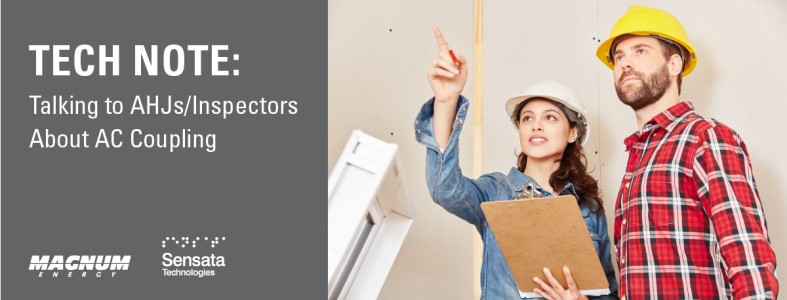
Issue Reported
Inspectors are not clear which inverter in an AC coupled system is selling back to the utility.
System Components
Grid-tied systems that involve battery backup can add a level of complexity during the permitting process. Let’s start with the system components and how they are connected.
An AC coupled battery-based application has two different electrical systems in the same application: the utility-interactive inverter, and the battery-based inverter/charger. The utility-interactive device (grid-tied inverter) can either be microinverters or string inverters. If there is a grid failure, the grid-tied inverter will disconnect from the utility to prevent electrifying the grid and creating a safety hazard. A non-grid interactive, bi-directional battery-based inverter/charger along with a sub-panel allows the household essential loads to be powered during an outage. When AC coupled with a grid-tied inverter into the sub-panel, the PV production that would otherwise be wasted can now be utilized to power the essential loads during a power outage. In this scenario, the AC main panel serviced by the grid remains de-energized as the non-grid interactive inverter/charger’s internal AC transfer relay prevents any current from being exported to the main panel or grid.
The microinverters or string inverters are the system components that need to adhere to IEEE 1547 compliance for grid connection, as the power from the battery-based inverter does not flow in the grid’s direction.
The ability to connect both of the inverter’s AC circuits in parallel with the household circuits into a sub-panel, then using the utility power to continue to power loads and charge the batteries from the AC side, is referred to as AC coupling.
It is important to note that the Magnum Energy MS-PAE series inverter/charger is certified UL-1741 as Non-Grid Interactive. This inverter/charger topology will not allow it to be grid interactive; however, it can be wired in such a way to provide the AC voltage and frequency reference needed for the grid-tied inverter to operate while using the renewable energy resource(s), and to provide power to the home during a power outage. In an AC coupled application, where the MS-PAE is installed, the AC outputs of both systems synchronize in the essential loads sub-panel.
The battery-based inverter/charger must have inverter safety rating UL 1741. No grid-tied certifications are necessary because the Magnum ME-PAE inverter is not grid interactive.
In Standby Mode, with grid or generator AC present on the MS-PAE’s input, the internal AC transfer relay is automatically closed to pass through the AC from which it is connected (i.e. grid or generator) to the essential loads sub-panel.
In Inverter Mode, the MS-PAE’s internal AC transfer relay is automatically opened to convert DC energy stored in its battery bank to provide AC power to the loads in the sub- panel.
Summary
The MS-PAE is UL-1741 certified as a Non-Grid Interactive inverter and does not and cannot export electricity to the utility grid. When this inverter is AC coupled with a grid-tied inverter, and grid is available, excess renewable energy can be forced backward − by the grid-tied inverter − through the MS-PAE to the utility main service panel.
During a power outage, the AC transfer relay inside the MS-PAE will automatically de-couple from the utility grid and power the essential loads sub-panel to prevent energizing the grid and creating a hazard.
When the inverter/charger is AC coupled with a string inverter or microinverter, the AC outputs of both couple together and synchronize in the essential loads sub-panel AC bus. The interruption in grid power shuts down the grid-interactive inverters for at least 300 seconds (5 minutes), and will reconnect if and only if it references grid quality voltage and frequency. The battery based MS-PAE inverter/charger will provide this reference to allow the use of the renewable energy resources. When the grid returns, the inverter/charger’s internal AC transfer relay is closed and passes current through into the essential loads sub-panel, and charges the batteries if necessary. When the battery based inverter/charger’s internal AC transfer relay is closed, excess PV harvest will backfeed into the AC main panel and be exported to the grid (net metered). The key item to note, is the branch circuit of the grid-tied inverters that is selling through the battery-based Magnum inverter/charger. This branch circuit would be the point of interconnect as well. For example, the utility main panel may have a 30-amp 2-pole breaker feeding to the AC Input of the Magnum MS-PAE but the load center on the output of the Magnum MS-PAE has a 20-amp 2-pole breaker feeding the grid-tie inverter. This 20-amp breaker is considered the point of interconnect for the grid tie system. In this occurrence, electrically, it is as if the Magnum equipment is not there.
The MS-PAE has two operating modes, “standby mode”, passing AC current through to the subpanel and charging if necessary, or “inverter mode”, pulling current from the battery bank to power essential loads in the sub-panel.
